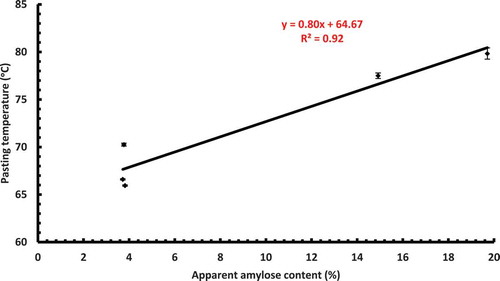Abstract
The effect of different rehydration temperatures (30, 40, and 50°C) and cooking times (2.7, 4.7, 6.7, 8.7, and 10.7 min) at 95°C on the pasting properties of three glutinous varieties (Thadokkham-11, Thadokkham-8, and Hom Mali Niaw) from Lao People’s Democratic Republic was investigated using rapid visco analyzer. Non-glutinous varieties (IR64 and Doongara) were also analyzed to compare glutinous (amylose <4.5%) and non-glutinous (amylose >15%) varieties. All rice flours took up water at significantly (p < 0.05) higher rates in the case of increased temperature and soaking time, resulting in a decrease in the onset temperature for pasting. Among the glutinous rices, Thadokkham-8 showed a significant (p < 0.05) decrease in peak viscosity in response to increased rehydration time and temperature. For this variety maximum viscosity (2403.3 mPas) was observed at 1 min of rehydration at 30°C and minimum viscosity (1852.0 mPas) at 15 min of rehydration at 50°C. The viscosity values of Thadokkham-11 and Hom Mali Niaw varieties increased to their highest values (1608.7 and 1477.7 mPa.s, respectively) with an increase in temperature to 40°C for 1 min. In general, the glutinous rices produced weaker gel than non-glutinous rices. Extended holding at cooking temperature (95°C) had a more significant (p < 0.05) effect on the glutinous varieties Thadokkham-8 and Thadokkham-11 than on the non-glutinous varieties (IR64 and Doongara) used in this study.
INTRODUCTION
Rice (Oryza sativa L.) has been a staple food in the majority of countries in the Asian continent, and its consumption is also growing in other parts of the world following changes in demography and in the eating habits of the population. It has been reported that rice has been cultivated in China and Thailand dating from about 6000 B.C.[Citation1,Citation2] There are different cultivars of rice grown throughout the world,[Citation3] each cultivar exhibiting distinct physico-chemical properties, and the type of the starch present influencing the cooking quality.[Citation4] Consumer preference is normally dependent on the growing location and this is a crucial factor for the selection and utilization of rice cultivars in a given location.[Citation5]
Rice is generally classified into glutinous and non-glutinous categories on the basis of the type of starch found in the endosperm. There are two types of starch found in rice, namely, amylose and amylopectin. Amylose consists predominantly of linear chains of α-D-glucose units, whereas amylopectin has a more branching tree-like structure.[Citation6] The proportion of amylose and amylopectin strongly affects the appearance, as well as the cooking characteristics of rice grain.[Citation7] When the amylose content in rice is lower than 5%, the rice is classified as glutinous.[Citation8] Glutinous rice, also known as sticky or waxy rice, has a chalky and opaque endosperm because of the presence of air spaces between the starch granules.[Citation9] When cooked, the grain usually loses its shape and becomes very sticky.[Citation10] On the other hand non-glutinous or non-waxy rice kernels have a translucent appearance and contain amylose as well as amylopectin. The cooked grain of non-waxy rice tends to retain its shape and is less sticky.[Citation11] Waxy varieties of rice are grown in many countries, including Lao People’s Democratic Republic (PDR), Thailand, China, Myanmar, Vietnam, Cambodia, Japan, Bangladesh, and India.[Citation12,Citation13] It is consumed as a sweet dish, as a breakfast cereal, or as a speciality steamed rice in banana leaves in Thailand, Myanmar, Cambodia, India, China, and Vietnam. In Lao PDR, waxy rice is a staple food which consumed by most of the population on a daily basis. Lao PDR has the highest per capita consumption of rice in the world,[Citation14] and 85% of the rice produced is the glutinous type.[Citation15] Among the wide range of improved glutinous rice varieties grown in lowland farming systems in Lao PDR are: Hom Mali Niaw (HMN), Thadokkham-8 (TDK8), and Thadokkham-11 (TDK11).[Citation16]
A knowledge of pasting properties is a key indicator of the processing quality of cereals including rice and rice products. For example, an understanding of the pasting behavior can help a processor in optimizing ingredient concentrations and temperature-pressure-shear limits when producing a desired product.[Citation17] Pasting properties are often estimated from pasting curves obtained using a rapid visco analyzer (RVA), a temperature controlled viscometer that monitors the resistance of a cereal grain sample to a specified shear. At the beginning, the RVA was introduced in 1980s as a means of rapidly measuring the extent of sprout damage in wheat affected by rain before harvest.[Citation18] Originally, it was built to operate at a constant temperature (95°C), but the addition of variable and controlled heating and cooling made the instrument more versatile, and enabled its use in the measurement of the pasting properties of other cereal starches under variable conditions.[Citation19] Currently the RVA is an industry-wide instrument which is used extensively for product development, quality, and process control and quality assurance of various cereals and starches.[Citation20] Standard methods for measuring starch pasting properties have been developed and have also been approved by the American Association for Cereal Chemists (AACC).[Citation21] However, the ability of RVA to differentiate between samples and to predict the quality of products may vary under various operating conditions.[Citation22–Citation24] The pasting properties measured by RVA can indicate the cooking characteristics of rice to certain extent.[Citation25] Cooking time is normally the time required for 90% of the kernels to become completely translucent when cooked by immersion in distilled water at 95 ± 1°C.[Citation26] However, for RVA analysis, the grain is ground to millimeter size. Therefore, it is not the same as cooking whole grains, but the technique is still found to provide useful information on the cooking properties of rice.[Citation27] Numerous studies have been done aimed at predicting rice cooking behavior.[Citation28,Citation29] In most of these studies the focus has generally been to develop a link between cooking time and rice physicochemical characteristics.[Citation30] It has been widely reported that kernel size and shape (especially thickness) are the key factors influencing cooking time, but cooking time is also dependent on the composition of the rice kernel, as rice with high protein[Citation31] and amylose contents[Citation4] has been found to have a longer cooking time. Glutinous rice varieties with low amylose content have been found to have different pasting properties than non-glutinous varieties.[Citation32,Citation33]
Prior to cooking, the soaking (rehydration) makes the grain softer, enabling water uptake by the starch during gelatinization.[Citation34] Rehydration is a slow and diffusion limited process. Besides the inherent effect of rice kernel composition and internal structure, diffusivity of water is a function of time and temperature.[Citation35] Warm water rehydration is a common method used to shorten the soaking time, because higher temperature will increase the hydration and diffusion rates. Rehydration should be done below the starch gelatinization temperature in order to reduce the leaching of solids and unintended gelatinization during this process.[Citation29] Thus, to improve the cooking properties and quality, rice is sometimes soaked in water for hours before cooking; however, there is limited data available relating to the effects of soaking temperature and soaking time for different types of rice.[Citation36] This also applies to glutinous varieties of rice, as systematic studies on the effects of soaking time and temperature on glutinous varieties are very limited in the literature. Moreover, no such information is available on the glutinous varieties that are widely grown and consumed in Lao PDR. This study was aimed at investigating the effect of rehydration time and temperature and extended holding during cooking, on the pasting properties of the common Laotian glutinous rice cultivars. Two non-glutinous rice varieties were used as reference rice samples for comparison purposes. The results of the study provide a new data in the literature on the pasting properties of common Laotian glutinous rice varieties.
MATERIALS AND METHODS
Materials
Three cultivars of glutinous rice (TDK11, TDK8, and HMN) were used in this study. The freshly harvested and milled TDK8 was provided by National Agriculture and Forestry Research Institute (NAFRI), Lao PDR, while about 8-months old TDK11, HMN, and the reference non-glutinous rice varieties, IR64 and Doongara (DG), were provided by Rice Research Australia Pty Ltd (RRAPL), Mackay, Qld, Australia.
Grinding of Rice Kernels
All rice samples were ground to flour using a hammer mill equipped with a plate of 0.75 mm size. The samples which passed through this plate were used for RVA analysis.
Apparent Amylose Content (AAC)
The AAC of rice samples was determined by iodine colorimetric method.[Citation37] This method is based on the fact that iodine-amylose complex formation gives a blue color but iodine-amylopectin gives a purple color. This means that the iodine-amylose complex absorbs other light spectrums, but reflects the blue. Measuring the absorbance in non-blue region (peak absorbance at 600 nm) will provide the amount of amylose present in a sample.[Citation38] Samples (20 ± 0.1 mg) in a tube (round bottom with Teflon cap) were dispersed with 8 mL 90% dimethyl sulfoxide (DMSO) (v/v) and thoroughly mixed with vortex for 5 min. To establish a standard curve, a series of potato amylose (Sigma A-0512) and waxy maize amylopectin (Sigma S-9679) mixtures at different ratios at the same solids concentrations were dissolved in 90% DMSO (v/v) in the same way as the test samples. The tubes containing samples were heated in a water bath at 85°C for 15 min with intermittent mixing, allowed to cool to room temperature (~45 min) and then diluted to 25 mL with deionized water. Then, 1 mL of the diluted solution was mixed with 40 mL of deionized water and 5 mL iodine reagent (2.5 × 10–3 M I2 /6.5 × 10–3 M KI) in a 50 mL volumetric flask. The tubes with these diluted solutions were vortexed for thorough mixing and left for 15 min at room temperature for color development. The absorbance of the standards and samples was measured at 600 nm against a blank reagent as the reference. The AAC was determined from the amylopectin/amylose standard curve.
Pasting Properties
The pasting properties of rice flours were determined according to the AACC International Method 61-02.01[Citation21] by using a RVA (3D model Thermocline Windows Control and analysis software, Version 1.2 [New Port Scientific, Sydney, Australia]). To calculate the sample size for RVA, the moisture contents of all the samples were measured according to the AACC International Method 44-40.01 (AACC Citation1999) by using a vacuum oven. Based on the moisture contents, the sample and deionized water required for each cultivar were calculated as follows: TDK11 (3.00 g sample and 25 mL deionised water), TDK8 (3.01 g sample and 25 mL deionized water), HMN (3.01 g sample and 25 mL deionized water), IR64 (3.02 g sample and 25 mL deionized water), and DG (3.00 g sample and 25 mL deionized water). Deionized water was dispensed in RVA canisters. Accurately weighed samples were transferred onto a water surface in the canisters. Subsequently, a RVA paddle was placed in each canister and firmly inserted into the RVA. Samples were mixed at 960 RPM for 10 s to make a homogeneous solution. After 10 s, the RPM was reduced to 160, which was maintained until the end of the run. A standard program of heating and cooling cycles was: holding the sample at 50°C for 1 min, followed by heating to 95°C in 3.45 min; holding at 95°C for 2.7 min, then cooling to 50°C in 3.91 min and holding at 50°C for 1.24 min.
Effect of Rehydration Time and Temperature
The effect of rehydration time and temperature on the pasting properties of the rice flours was investigated by altering the standard AACC International Method. The rice flours were rehydrated at different temperatures for different periods of time: control (50°C for 1 min), t1 (50°C for 15 min), t2 (50°C for 30 min), t3 (40°C for 1 min), t4 (40°C for 15 min), t5 (40°C for 30 min), t6 (30°C for 1 min), t7 (30°C for 15 min), and t8 (30°C for 30 min). The remainder of the procedure was left unaltered. These temperature conditions were chosen based on the practical rehydration temperature of rice prior to cooking.
Effect of Holding Time at 95°C
The effect of holding time at 95°C on the pasting properties of rice flours was investigated by altering the standard AACC International Method. This was intended to determine the effect of prolong shear on the rice at the cooking temperature. The rice flours were held at 95°C for different time periods, control (2.7 min), T1 (4.7 min), T2 (6.7 min), T3 (8.7 min), and T4 (10.7 min). The rest of the procedure was left unaltered.
Statistical Analysis
All treatments were replicated three times to get mean values. The reported data for the pasting temperature (Ptemp), peak viscosity (Vp), trough viscosity (Vt), breakdown (BD), final viscosity (Vf), and setback (SB) for all rice the flours were analyzed by analysis of variance using Minitab R16 (Minitab® for Windows Release 16, Minitab Inc., Chicago) in order to determine significant differences. The data was then analyzed using Tukeys pair-wise comparison, at 5% level of significance, to compare the results between different treatments.
RESULTS AND DISCUSSION
AAC
The rice cultivars selected for this study represented a wide variation in AAC, ranging from 3.72 to 19.71% (). Previous studies reported that AAC of various waxy and non-waxy rice genotypes ranged from 0% to as high as 29.2%.[Citation17,Citation39] As expected, TDK8, TDK11, and HMN, contained very low levels of amylose, and are, therefore, classified as glutinous rice varieties, while IR64 and DG (with amylose contents in the range of 14.92 and 19.71%) are classified as non-glutinous rice varieties. The variation in AAC has been reported to differ with the botanical source of the starch and is usually affected by the climatic and soil conditions during grain development.[Citation40–Citation42] This study revealed how the glutinous and non-glutinous group would respond to an extension of rehydration and cooking time (holding at 95°C). The results (), show a positive correlation among the AAC and Ptemp; the higher the AAC the higher will be the Ptemp. The onset of gelatinization is indicated by the Ptemp. The glutinous varieties had significantly (p < 0.05) lower Ptemp than the non-glutinous cultivars (IR64 and DG) used in this study.
TABLE 1 Apparent amylose content (AAC) of selected rice varieties
Effect of Rehydration Time and Temperature on Pasting Properties
The viscograph is designed to study the three basic properties of starch. First, when starch particles are subjected to heat with water they will swell, that forms a paste and provides a body. The second important property of the starch is the stability of the body or paste or the viscosity. The third property is the extent of paste congelation while cooling. The representative RVA curves for selected glutinous rice varieties (TDK11, TDK8, and HMN) under standard analytical conditions showing all the pasting attributes, are presented in . The temperature at the onset of the rise in the viscosity, known as Ptemp, is considered as an indication of the minimum temperature required for cooking.[Citation43] The equilibrium point between starch granules swelling and polymer leaching is known as Vp. This normally happens close to 95°C in RVA analysis and can represent the cooking temperature of rice. It is the maximum viscosity attained by gelatinized starch during heating. Vp indicates the water binding capacity of starch granules[Citation44] at this temperature. In fact, this viscosity value also depicts a balance between water holding capacity and BD of starch at the shear rate. During the hold period at this temperature, the samples are subjected to a period of constant mechanical shear stress. Continuous stirring of the RVA pedal at high temperature (95°C) can result in disruption of starch granules and a reduction in viscosity, which eventually reaches to a minimum value, known as Vt.[Citation45] The difference between peak and Vt is commonly referred to as BD viscosity. Re-alignment of starch molecules occurs when the mixture is allowed to cool; consequently a gel is formed. This leads to enhanced viscosity known as Vf. It is usually considered a quality parameter to measure the strength of gel upon cooling.[Citation46] The range of the RVA curve between the trough and Vf is usually referred to as the SB region. The difference between the two ends of this region is known as SB viscosity.[Citation27] The effect of rehydration time and temperature on the pasting properties of glutinous and non-glutinous rice cultivars with various amylose contents used in this study is shown in , , , , , and .
FIGURE 2 Representative RVA curves of selected glutinous varieties (TDK11, TDK8, and HMN) at standard RVA analysis.
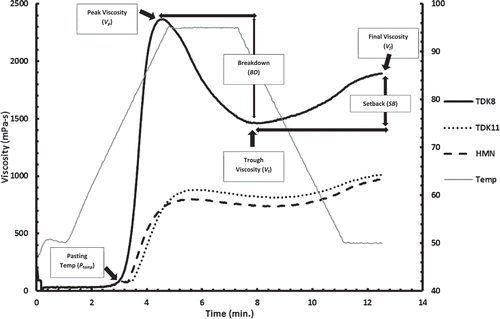
FIGURE 3 Effect of soaking time and temperature on the pasting temperature (Ptemp) of three different glutinous rice varieties; (a) TDK11, (b) TDK8, (c) HMN, and two non-glutinous rice varieties; (d) IR64, and (e) DG.
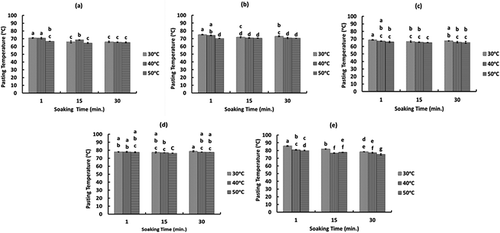
FIGURE 4 Effect of soaking time and temperature on the peak viscosity (Vp) of three different glutinous rice varieties; (a) TDK11, (b) TDK8, (c) HMN, and two non-glutinous rice varieties; (d) IR64 and (e) DG.
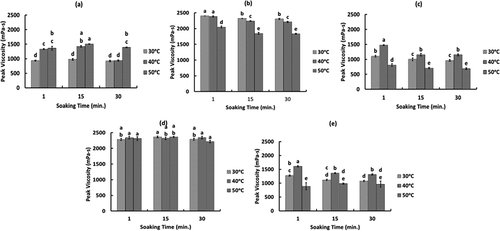
FIGURE 5 Effect of soaking time and temperature on the breakdown viscosity (BD) of three different glutinous rice varieties; (a) TDK11, (b) TDK8, (c) HMN, and two non-glutinous rice varieties; (d) IR64 and (e) DG.
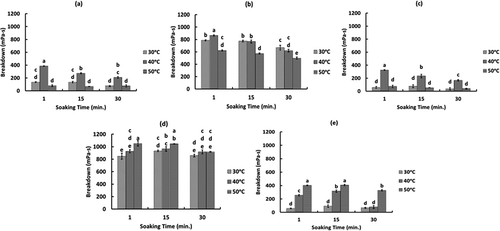
FIGURE 6 Effect of soaking time and temperature on the trough viscosity (Vt) of three different glutinous rice varieties; (a) TDK11, (b) TDK8, (c) HMN, and two non-glutinous rice varieties; (d) IR64 and (e) DG.

FIGURE 7 Effect of soaking time and temperature on the setback viscosity (SB) of three different glutinous rice varieties; (a) TDK11, (b) TDK8, (c) HMN, and two non-glutinous rice varieties; (d) IR64 and (e) DG.

FIGURE 8 Effect of soaking time and temperature on the final viscosity (Vf) of three different glutinous rice varieties; (a) TDK11, (b) TDK8, (c) HMN, and two non-glutinous rice varieties; (d) IR64 and (e) DG.
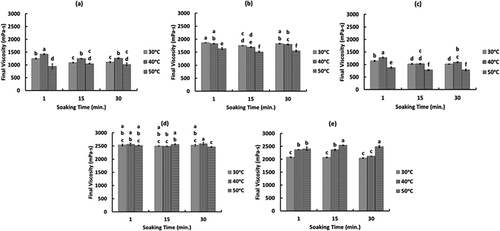
Ptemp
Variations in the Ptemp are governed by a range of factors but the type of starch in the endosperm is the most significant factor.[Citation47] It is now a very well-established concept that water uptake by the starch granules is directly proportional to time and temperature of rehydration.[Citation48,Citation49] Higher water uptake will result in a decrease in the onset Ptemp, which is also a trend observed in all glutinous rice varieties investigated in this study (). This effect was not found in the non-glutinous variety IR64 but was found in the variety DG. This indicates that the effect is variety dependent and will certainly be influenced by the physicochemical characteristics of the grain.[Citation33]
Ptemp for TDK11 after 1 min of soaking was more significantly (p < 0.05) reduced at 50°C, when compared with 30 and 40°C. However, soaking time did not have a significant (p > 0.05) effect. A similar trend was observed for the varieties TDK8 and HMN. The results revealed that 1 min of soaking of flour particles (≤750 µm) at ambient temperature is optimum for the onset of gelatinization.[Citation50] Among the waxy rices, TDK8 exhibited the highest Ptemp during all rehydration conditions (). Pasting properties are related to amylopectin branch chain length distribution. The presence of longer chain branches contributes to increased Ptemp.[Citation51] The higher proportion of long chains (degree of polymerization (DP) ≥ 37) in amylopectin results in a relatively high level of stabilized starch granules, leading to higher Ptemp or the gelatinization temperature.[Citation52] IR64 and DG (non-glutinous varieties) had higher Ptemp than the glutinous varieties TDK11, TDK8, and HMN. This means that the absence or low amount of amylose can also facilitate the gelatinization of amylopectin. Similar observations have also been reported by Tran and co-workers for other rice varieties.[Citation53]
Vp
The temperature of soaking had a much greater impact on Vp than the duration of soaking. Different glutinous rice cultivars behaved in a diverse manner when treated with various soaking times and temperatures (). The Vp of TDK11 () showed a significant (p < 0.05) increase when soaked at 40°C, while a further increase in temperature had no significant (p > 0.05) effect. It is also observed that the duration of soaking had no significant (p > 0.05) effect on Vp, with the exception of 30 min of soaking at 40°C which resulted in a significant (p < 0.05) decrease in Vp. TDK8 showed a significant (p < 0.05) decrease in the Vp with increase in soaking temperature. Maximum viscosity (2403.3 mPa.s) was observed from 1 min of rehydration at 30°C, and minimum viscosity (1852.0 mPa.s) was observed after 15 min of rehydration at 50°C (). HMN showed a significant (p < 0.05) increase in Vp at 40°C, with a further increase in temperature resulting in a significant (p < 0.05) decrease in viscosity (). TDK8 showed a significant (p < 0.05) decrease in the Vp with increase in rehydration time and temperature. Maximum viscosity (2403.3 mPa.s) was observed after 1 min of rehydration at 30°C, and minimum viscosity (1852.0 mPa.s) occurred after 15 min of rehydration at 50°C (). The Vp of TDK11 and HMN increased to highest values (1608.7 and 1477.7 mPa.s, respectively) with an increase in temperature up to 40°C for 1 min ( and ). A further increase in either rehydration time or temperature decreased the Vp in both TDK11 and HMN. HMN showed the lowest Vp for all treatments. You et al.[Citation54] suggested that the amylopectin with more short chains (DP6-12) would result in a lower Ptemp and Vp, as the short branch chains do not provide strong interactions[Citation55] to maintain the integrity of the swollen granules resulting in lower Vp. Vp is the balance between starch swelling and BD at the given shear rate. In the non-glutinous rices, the variety DG showed susceptibility toward changes in rehydration conditions (), with an increase in time and temperature of soaking increasing the equilibrium point of granules swelling and leaching of amylose.[Citation56] IR64 was quite stable in all soaking conditions and no significant changes were recorded ().
Vt and BD
TDK11 and HMN flours showed significantly higher BD at 40°C ( and ). Among the waxy rice varieties, higher BD was observed for TDK8 (). Mostly BD is correlated with Vp, the higher the Vp the greater the level of BD.[Citation57] In general, a longer soaking time was not reflected in significant differences in the Vt of the rice samples (). However, the temperature of soaking showed reduction in the Vt in all rice varieties with the exception of TDK8 which actually showed an increasing trend. The reduction in Vt was much greater for the samples soaked at 50°C. Thus, the BD of starch granules exhibited a strong positive correlation with soaking time and temperature among both the glutinous and non-glutinous rice cultivars evaluated (). A high level of BD is associated with a high degree of collapse of swollen starch granules (low Vt). This may indicate softer texture of the gel or cooked grain.
Vf and SB
The Vf was measured by cooling the sample to 50°C. The increase in viscosity due to cooling reflects the effects of temperature on viscosity and retrogradation of starch. Retrogradation ability of straight chain amylose molecules is much higher and faster than for branched amylopectin.[Citation58] The glutinous varieties containing a very low amount of amylose retrogrades very slowly.[Citation59] Similar observations were recorded in this study through the observation of reduced Vf of the gel ( and ). Among the glutinous rices, TDK11 () and TDK8 () showed significantly (p < 0.05) high SB at 40°C from soaking for 1 min while HMN () showed significantly (p < 0.05) high SB at 50°C after soaking for 1 min. Non-glutinous rices IR64 and DG ( and , respectively) showed significant (p < 0.05) increase in SB with increase in soaking temperature. For both varieties maximum SB was observed at 50°C. It is observed that among the soaking conditions only temperature significantly affects the SB rather than time of soaking.
With a decrease in soaking temperature to less than 40°C, strong resistance was recorded by the RVA paddle resulting in high Vf. The soaking time did not show a strong effect on the Vf but all glutinous varieties showed a decline in Vf at higher soaking temperature. Among three varieties, TDK8 () showed the greatest sensitivity to soaking temperature. Similar effects were observed in the non-glutinous rices (both IR64 and DG), but the retrogradation would be higher in non-glutinous rices due to the presence of higher amounts of amylose.
Effect of an Extension of Holding Time at 95°C on Viscosity
Increased shear at cooking temperature is expected to increase the BD, and reduce trough and final viscosities. The effect of extended holding time at 95°C on the pasting properties of all rice cultivars used in this study is shown in . As expected, there was a significant difference (p < 0.05) in the pasting properties of all five glutinous and non-glutinous rice cultivars used in this study. Vp for all cultivars with various amylose contents was significantly (p < 0.05) different (). However, there was no significant (p > 0.05) difference of holding time at 95°C on the Vp of TDK8, HMN, DG, and IR64 but Vp of TDK11 flour increased significantly (p < 0.05) with an increase in holding time from the control to 4.7 min, but remained constant with any further increase in holding time. In this case TDK11 was found to be more resistant than the other varieties to BD of the swelled starch particles during shearing at 95°C. This indicates that not only the amylose content, but also the starch grain structure, will contribute to the BD of gelatinized and swelled starch.
FIGURE 9 Effect of extended holding time at 95°C on the pasting properties of glutinous and non-glutinous rice varieties; (a) Peak viscosity (Vp), (b) Trough viscosity (Vt), (c) Breakdown (BD), (d) Final viscosity (Vf), and (e) Setback (SB).
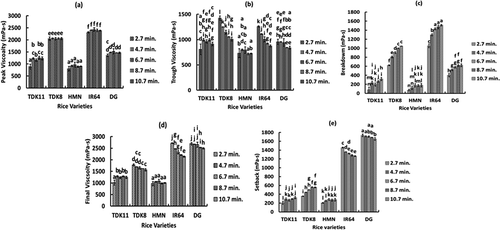
The Vp is followed by the disruption of starch granules during holding at the same temperature. This period is usually accompanied by a reduction in the viscosity, which eventually reaches a minimum value. This minimum viscosity attained by the starch granules during RVA run is known as Vt.[Citation17] The loss of viscosity is caused by leaching of amylose and also BD of the swelled granules due to the shear in RVA. A lot of variation was observed in Vt of the glutinous and non-glutinous cultivars used in present study (), with extended holding at higher temperature (95°C) having a significant (p < 0.05) effect on the glutinous cultivars TDK11 and TDK8, and for non-glutinous cultivar IR64. The variety DG showed resistance toward extended heating up to 6.7 min, after which there was a significant (p < 0.05) disruption of granules and possibly leaching of amylose from starch granules was observed, resulting in decrease in Vt. While HMN flour was quite stable with extended holding at 95°C, there was no significant (p > 0.05) change in Vt. Among the glutinous rices, maximum BD was observed in TDK8 followed by TDK11, while the least amount of BD was observed in HMN (). BD of TDK11 and HMN significantly (p < 0.05) increased up to 4.7 min, with further cooking having no significant (p > 0.05) effect on BD. Significant (p < 0.05) BD was observed in TDK8 up to 6.7 min of cooking, further cooking had no significant (p > 0.05) effect. In the non-glutinous rices, IR64 showed higher BD than DG. Both varieties had significantly (p < 0.05) higher BD and leaching of amylose up to 4.7 min of cooking, with further cooking having no significant (p > 0.05) effect on BD in either of these varieties.
Flour of glutinous rice cultivars produced weaker gels at the final temperature of cooling (50°C) than the non-glutinous flours (). Among the glutinous rices, TDK8 had significantly (p < 0.05) higher Vf and SB than the other glutinous rices (TDK11 and HMN; and ). Significantly (p < 0.05) higher Vf and SB was observed in TDK11 up to 4.7 min of cooking, with a further increase in cooking time having an effect on SB and Vf. TDK8 behaved in an entirely different manner than TDK11. Increased cooking time resulted in a significantly decline in Vf and greater SB up to 4.7 min. Further cooking resulted in low Vf, but the effect was non-significant. There was no significant (p > 0.05) effect of extended cooking on the Vf and SB for the variety HMN. Among the non-glutinous rices, IR64 showed a significant (p < 0.05) decline in Vf and SB up to 4.7 min, with any further increase not resulting in further significant differences in either Vf and SB. The variety DG showed quite stable behavior toward extended cooking, resulting in no significant differences in Vf and SB. Therefore, in general, the effect of holding at 95°C and prolonged shear exhibited the same effects on glutinous and non-glutinous varieties and was variety dependent. Hasjim and co-workers[Citation60] also reported that increasing the cooking time at 95°C longer than 4 min caused only small changes in the trough and the Vf of polished long-grain rice flour.
CONCLUSION
A knowledge of rehydration and cooking attributes of various glutinous and non-glutinous rice varieties is very important, as rice is a major ingredient in many processed foods. As expected, significant differences in the pasting properties of various glutinous varieties from Lao PDR were observed. Water uptake by the flour of all rice varieties was directly proportional to the time/temperature of rehydration. Ptemp depends on the amylose content, the higher the amylose the higher will be the onset temperature of starch gelatinization. Among the glutinous rice varieties tested, TDK8 showed the greatest response to rehydration conditions, resulting in highest Vp. The rice cultivars evaluated in the study showed diverse response when treated with extended cooking. For the glutinous variety TDK8 and non-glutinous variety, IR64 starch granules showed a higher BD in response to extended cooking, resulting in reduced Vt and reduced retrogradation. Therefore, it is recommended that for glutinous rices, especially TDK8, extended cooking will result in a better cooked product. This work has generated the pasting data for the most popular glutinous varieties consumed in Lao PDR. Further work is being undertaken on the cooking and textural attributes of whole grain of these glutinous varieties as RVA analysis can only use ground samples.
ACKNOWLEDGMENTS
The authors would like to thank Dr. John M. Schiller (Honorary Senior Fellow, School of Agriculture and Food Sciences, The University of Queensland) for proofreading the manuscript, Andrew Barfield, Russell Ford (Research Manager, Sunrice, RRAPL), Peter Snell (NSW DPI), and NAFRI (Lao PDR) for providing the paddy and rice samples for this research.
FUNDING
The authors would like to thank the Australian Centre for International Agricultural Research (ACIAR) for providing financial support to undertake this research.
Additional information
Funding
REFERENCES
- Zhang, C.; Hung, H.C. Jiahu 1: Earliest Farmers Beyond the Yangtze River. Antiquity 2013, 87, 46–63.
- Childs, N.W. Production and Utilization of Rice. In: RICE—Chemistry and Technology, 3rd Ed.; Champagne, E.T.; Ed.; ACCE: St. Paul, Minnesota, 2004; 1–23.
- Kambo, R.; Yerpude, A. Classification of Basmati Rice Grain Variety Using Image Processing and Principal Component Analysis. International Journal of Computer Trends and Technology 2014, 11 (2), 80–85.
- Yu, S.; Ma, Y.; Sun, D. Impact of Amylose Content on Starch Retrogradation and Texture of Cooked Milled Rice During Storage. Journal of Cereal Science 2009, 60 (20), 139–144.
- Allahgholipour, M.; Ali, A.J.; Alinia, F.; Nagamine, T.; Kojima, Y. Relationship Between Rice Grain Amylose and Pasting Properties for the Breeding Better Quality Rice Varieties. Plant Breeding 2006, 125, 357–362.
- Yu, X.; Yu, H.; Zhang, J.; Shao, S.; Xiong, F.; Wang, Z. Endosperm Structure and Physicochemical Properties of Starches From Normal, Waxy, and Super-Sweet Maize. International Journal of Food Properties 2015, 18, 2825–2839.
- Ahromrit, A.; Ledward, D.A.; Niranjan, K. High Pressure Induced Water Uptake Characteristics of Thai Glutinous Rice. Journal of Food Engineering 2006, 72 (3), 225–233.
- Prathepha, P.; Daipohnak, V.; Samappito, A.; Balmal, V. An Assessment of Alkali Degradation, Waxy Protein, and Their Relation to Amylose Content in Thai Rice Cultivars. ScienceAsia 2005, 31, 69–75.
- Zhou, Z.; Robards, K.; Helliwell, S.; Blanchard, C. Ageing of Stored Rice: Changes in Chemical and Physical Attributes. Journal of Cereal Science 2002, 35 (1), 65–78.
- Noosuk, P.; Hill, S.E.; Pradipasena, P.; Mitchell, J.R. Structure-Viscosity Relationship for Thai Rice Starches. Starch/Starke 2003, 55, 337–344.
- Kang, M.; Rico, C.W.; Lee, S. Comparative Analysis of the Physicochemical Properties of Rice Endosperm from Different Non-Glutinous Rice Varieties. Journal of the Korean Society for Applied Biological Chemistry 2009, 52 (6), 582–589.
- Calingacion, M.; Laborte, A.; Nelson, A.; Resurreccion, A.; Concepcion, J.C.; Daygon, V.D.; Mumm, R.; Reinke, R.; Dipti, S.; Bassinello, P.Z.; Manful, J.; Sophany, S.; Lara, K.C.; Bao, J.; Xie, L.; Loaiza, K.; El-Hissewy, A.; Gayin, J.; Sharma, N.; Rajeswari, S.; Manonmani, S.; Rani, N.S.; Kota, S.; Indrasari, S.D.; Habibi, F.; Hosseini, M.; Tavasoli, F.; Suzuki, K.; Umemoto, T.; Boualaphanh, C.; Lee, H.H.; Hung, Y.P.; Ramli, A.; Aung, P.P.; Ahmad, R.; Wattoo, J.I.; Bandonill, E.; Romero, M.; Brites, C.M.; Hafeel, R.; Lur, H.; Cheaupun, K.; Jongdee, S.; Blanco, P.; Bryant, R.; Lang, N.T.; Hall, R.D.; Fitzgerald, M. Diversity of Global Rice Markets and the Science Required for Consumer-Targeted Rice Breeding. Plos One 2014, 9 (1), 1–12.
- Mar, N.N.; Umemoto, T.; Abdulah, S.N.A.; Maziah, M. Chain Length Distribution of Amylopectin and Physicochemical Properties of Starch in Myanmar Rice Cultivars. International Journal of Food Properties 2015, 18, 1719–1730.
- Schiller, J.M.; Appa Rao, S.; Inthapanya, P.; Hatsadong. Glutinous Rice in Laos. In Rice in Laos; Schiller, J.M.; Chanphengxay, M.B.; Linquist, B.; Appa Rao, S.; Eds.; International Rice Research Institute: Las Baños, Philipines, 2008; 197–214.
- FAO. Food and Agriculture Organization. FAO/WFP Crop and Food Security Assessment Mission to Lao People’s Democratic Republic; FAO: Rome, 2011.
- Sengxua, P.; Bouahom, B.; Sihathep, V.; Thiravong, K.; Wade, L.; Kato, Y.; Samson, B. Agricultural Intensification for Food Security in Rainfed Rice-Based Systems of Southern Lao PDR. In: A Policy Dialogue on Rice Futures: Rice-Based Farming Systems Research in Mekong Region; Robins, L.; Ed.; Australian Centre for International Agricultural Research: Canberra, Australia, 2014; 47–52.
- Dang, J.M.; Copeland, L. Genotype and Environmental Influences on Pasting Properties of Rice Flour. Cereal Chemistry 2004, 81 (4), 486–489.
- Ross, A.S.; Walker, C.E.; Booth, R.I.; Orth, R.A.; Wrigley, C.W. The Rapid Visco-Analyser: A New Technique for the Estimation of Sprout Damage. Cereal Foods World 1987, 32, 827–829.
- Walker, C.E.; Ross, A.S.; Wrigley, C.W.; McMaster, G.J. Accelerated Starch Paste Characterization with the Rapid Visco-Analyser. Cereal Foods World 1988, 33, 491–493.
- Doutch, J.; Bason, M.; Franceschini, F.; James, K.; Clowes, D.; Gilbert, E.P. Structural Changes During Starch Pasting Using Simultaneous Rapid Visco Analysis and Small-Angle Neutron Scattering. Carbohydrate Polymers 2012, 88 (3), 1061–1071.
- AACC. American Association for Cereal Chemists. Determination of the Pasting Properties of Rice with the Rapid Visco Analyser, AACC International Method 61-02.01, USA: AACC, 1999.
- Konik, C.; Miskelly, D.M.; Gras, P.W. Contribution of Starch and Non-Starch Parameters to the Eating Quality of Japanese White Salted Noodles. Journal of the Science of Food and Agriculture 1992, 58, 403–406.
- Batey, I.L.; Curtin, B.M.; Moore, S.A. Optimization of Rapid-Visco Analyser Test Conditions for Predicting Asian Noodle Quality. Cereal Chemistry 1997, 74, 497–501.
- Batey, I.L.; Curtin, B.M. Effects on Pasting Viscosity and Flour from Different Operating Conditions for the Rapid Visco Analyser. Cereal Chemistry 2000, 77 (6), 754–760.
- Champagne, E.T.; Bett, K.L.; Vinyard, B.T.; McClung, A.M.; Barton II, F.E.; Moldenhauer, K.; Linscombe, S.; McKenzie, K. Correlation Between Cooked Rice Texture and Rapid Visco Analyser Measurements. Cereal Chemistry 1999, 76 (5), 764–771.
- Ranghino, F. Valutazione Delle Resistenza del Riso Alla Cottura in Base Al Tempo di Gelatinizzazione dei Granelli [Evaluation of Resistance of Rice to Cooking, According to the Time of Gelatinization of the Grains]. II Riso 1966, 15, 117–127.
- Zhu, B.; Li, B.; Gao, Q.; Fan, J.; Gao, P.; Ma, M.; Feng, X. Predicting Texture of Cooked Blended Rice with Pasting Properties. International Journal of Food Properties 2013, 16, 485–499.
- Mohapatra, D.; Bal, S. Cooking Quality and Instrumental Textural Attributes of Cooked Rice for Different Milling Fractions. Journal of Food Engineering 2006, 73, 253–259.
- Han, J.; Lim, S. Effect of Presoaking on Textural, Thermal, and Digestive Properties of Cooked Brown Rice. Cereal Chemistry 2009, 86 (1), 100–105.
- Vidal, V.; Pons, B.; Brunnschweiler, J.; Handschin, S.; Rouau, X.; Mestres, C. Cooking Behaviour of Rice in Relation to Kernel Physicochemical and Structural Properties. Journal of Agricultural and Food Chemistry 2007, 55, 336–346.
- Martin, M.; Fitzgerald, M.A. Proteins in Rice Grains Influence Cooking Properties. Journal of Cereal Science 2002, 36, 285–294.
- Huaisan, K.; Uriyapongson, J.; Rayas-Duarte, P.; Alli, I.; Srijesdaruk, V. Effect of Food Additives on Rheological and Textural Properties of Frozen High Amylose Rice Starch Gels. International Journal of Food Properties 2009, 12, 145–161.
- Bao, J.; Kong, X.; Xie, J.; Xu, L. Analysis of Genotypic and Environmental Effects on Rice Starch. 1, Apparent Amylose Content, Pasting Viscosity, and Gel Texture. Journal of Agricultural and Food Chemistry 2004, 52, 6010–6016.
- Kashaninejab, M.; Maghsoudlou, Y.; Rafiee, S.; Khameiri, M. Study of Hydration Kinetics and Density Changes of Rice (Tarom Mahali) During Hydrothermal Processing. Journal of Food Engineering 2007, 79 (4), 1383–1390.
- Bello, M.; Tolaba, M.P.; Aguerre, R.J.; Suarez, C. Modeling Water Uptake in a Cereal Grain During Soaking. Journal of Food Engineering 2010, 97, 95–100.
- Lee, Y.; Kum, J.; Ku, K.; Chun, H.; Kim, W. Changes in the Chemical Composition of Glutinous Rice During Steeping and Quality Properties of Yukwa. Korean Journal of Food Science and Technology 2001, 33 (6), 737–744.
- Hoover, R.; Ratnayake, W.S. Determination of Total Amylose Content of Starch. In Handbook of Food Analytical Chemistry—Water, Protein, Enzymes, Lipids, and Carbohydrates; Wrolstad, R.E.; Acree, T.E.; Decker, E.A.; Penner, M.H.; Reid, D.S.; Schwartz, S.J.; Shoemaker, C.F.; Smith, D.; Sporns, P.; Eds.; Wiley-Interscience: Hoboken, NJ, 2005; 689–691.
- Knuston, C.A.; Grove, M.J. Rapid Method for Estimation of Amylose in Maize Starches. Cereal Chemistry 1994, 71(5), 469–471.
- Kong, X.; Zhu, P.; Sui, Z.; Bao, J. Physicochemical Properties of Starches from Diverse Rice Cultivars Varying in Apparent Amylose Content and Gelatinisation Temperature Combinations. Food Chemistry 2015, 172, 433–440.
- Tashiro, T.; Wardlaw, I.F. The Effect of High Temperature on Kernel Dimensions and the Type and Occurrence of Kernel Damage in Rice. Australian Journal of Agricultural Research 1991, 42, 485–496.
- Singh, N.; Kaur, L.; Sandhu, K.S.; Kaur, J.; Nishinari, K. Relationships Between Physicochemical, Morphological, Thermal, Rheological Properties of Rice Starches. Food Hydrocolloids 2006, 20, 532–542.
- Wang, L.; Xie, B.; Shi, J.; Xue, S.; Deng, Q.; Wei, Y.; Tian, B. Physicochemical Properties and Structure of Starches from Chinese Rice Cultivars. Food Hydrocolloids 2010, 24, 208–216.
- Yadav, D.N.; Chhikara, N.; Anand, T.; Sharma, M.; Singh, A.K. Rheological Quality of Pearl Millet Porridge As Affected by Grits Size. Journal of Food Science and Technology 2014, 51 (9), 2169–2175.
- Shimelis, E.; Meaza, M.; Rakishit, S. Physicochemical Properties, Pasting Behaviour, and Functional Characteristics of Flours and Starches from Improved Bean (Phaseolus Vulgaris L.) Varieties Grown in East African. CIGRE—Journals 2006, 8, 1–18.
- Ragaee, S.; Abdel-Aal, E.M. Pasting Properties of Starch and Protein in Selected Cereals and Quality of Their Food Products. Food Chemistry 2006, 95 (1), 9–18.
- Cornejo-Villegas, M.A.; Acosta-Osorio, A.A.; Rojas-Molina, I.; Guriérrez-Cortéz, E.; Quiroga, M.A.; Gaytán, M.; Herrera, G.; Rodríguez-García, M.E. Study of the Physiochemical and Pasting Properties of Instant Corn Flour Added With Calcium Fibers from Nopal Powder. Journal of Food Engineering 2010, 66, 401–409.
- Thomas, R.; Bhat, R.; Kuang, Y.T.; Abdullah, W.W. Functional and Pasting Properties of Locally Grown and Imported Exotic Rice Varieties of Malaysia. Food Science and Technology Research 2014, 20 (2), 469–477.
- Buggenhout, J.; Brijis, K.; Delcour, J.A. Soaking Conditions During Brown Rice Parboiling Impact the Level of Breakage-Susceptible Rice Kernels. Cereal Chemistry 2014, 91 (6), 554–559.
- Briffaz, A.; Bohuon, P.; Méot, J.; Dornier, M.; Mestres, C. Modelling of Water Transport and Swelling Associated with Starch Gelatinization During Rice Cooking. Journal of Food Engineering 2014, 121, 143–151.
- Song, J.; Shin, M. Effects of Soaking and Particle Sizes on the Properties of Rice Flour and Gluten-Free Rice Bread. Food Science and Biotechnology 2007, 16 (5), 759–764.
- Jane, J.; Chen, Y.Y.; Lee, L.F.; McPherson, E.; Wong, K.S.; Radosavlijevic, M.; Kasemsuwan, T. Effects of Amylopectin Branch Chain Length and Amylose Content on the Gelatinization and Pasting Properties of Starch. Cereal Chemistry 1999, 76, 629–637.
- Koroteeva, D.A.; Kiseleva, V.I.; Krivandin, A.V.; Shatalova, O.V.; Blaszczak, W.; Bertoft, E.; Piyachomkwan, K.; Yuryev, V.P. Structural and Thermodynamic Properties of Rice Starches with Different Genetic Background. Part 2. Defectiveness of Different Supramolecular Structures in Starch Granules. International Journal of Biological Macromolecules 2007, 41, 534–547.
- Tran, U.T.; Okadome, H.; Murata, M.; Homma, S.; Ohtsubo, K. Comparison of Vietnamese and Japanese Rice Cultivars in Terms of Physicochemical Properties. Food Science and Technology Research 2001, 7 (4), 323–330.
- You, S.; Lim, S.; Lee, J.H.; Chung, H. Impact of Molecular and Crystalline Structures on in Vitro Digestibility of Waxy Rice Starches. Carbohydrate Polymers 2014, 112, 729–735.
- Chung, H.J.; Liu, Q.; Lee, L.; Wei, D. Relationship Between the Structure, Physicochemical Properties and in Vitro Digestibility of Rice Starches with Different Amylose Contents. Food Hydrocolloids 2011, 25, 968–975.
- Hasjim, J.; Enpeng, L.; Dhital, S. Milling of Rice Grains: Effects of Starch/Flour Structures on Gelatinization and Pasting Properties. Carbohydrate Polymers 2012, 92, 682–690.
- Higley, J.S.; Love, S.L; Price, W.J.; Nelson, J.E.; Huber, K.C. The Rapid Visco Analyser (RVA) As Tool for Differentiating Potato Cultivars on the Basis of Flour Pasting Properties. American Journal of Potato Research 2003, 80, 195–206.
- Suzuki, A.; Takeda, Y.; Hizukuri, S. Relationship Between the Molecular Structure and Retrogradation Properties of Tapioca, Potato, and Kuzu Starches. Journal of the Japanese Society for Starch Science 1985, 32, 205–212.
- Singh, H.; Lin, J.; Huang, W.; Chang, Y. Influence of Amylopectin Structure on the Rheological and Retrogradation Properties of Waxy Rice Starches. Journal of Cereal Science 2012, 56 (2), 367–373.
- Hasjim, J.; Li, E.; Dhital, S. Milling of Rice Grains: Effect of Starch/Flour Structures on Gelatinization and Pasting Properties. Carbohydrate Polymers 2013, 92 (1), 682–690.

